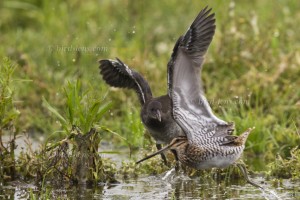Migration season starts in Germany right now. One of the best places to see especially the early fall migrants – the waders – is the old sewage farm in the north of Muenster, called Rieselfelder Munster. Early morning, 6:30 am. Still dawn. Haze over the water and I am watching through a well located hide here on the edge of the best lagoon, called E1. Waders are my main interest, but I would not complain, if an early Spotted Crake (Porzana porzana) or maybe Water Rail (Rallus aquaticus) show up. Great atmosphere although shortly after my arrival heavy clouds fill the air. A thunderstorm already in the morning?
In the background I hear the sounds of the Graylag Geese (Anser anser). And indeed, waders are abundant, but ducks are present as well. Honestly first, there is almost nothing to see but the sheer numbers of ducks. Gadwalls (Anas strepera), Mallards (Anas platyrhynchos), some Northern Shoveler (Anas clypeata), 1 Garganey (Anas querquedula) in non-breeding plumage, Common Pochards (Aythya ferina), Tufted Ducks (Aythya fuligula) and several Common Teal (Anas crecca) all are present. But the highlights of the observations from the Hide at the entrance to the pond are several Spotted Redshanks (Tringa erythropus) in non-breeding plumage slowly swimming right in front of the hide and in total 4 Ruffs (Calidris pugnax) on a muddy shore a bit in the background.
Unfortunately, the weather gets worse. The heavy clouds get thicker and thicker, more dark grey. Finally it starts to rain. These are not the right photographic conditions. I am already starting to leave at around 9:00 when an adult Eurasian Moorhen (Gallinula chloropus) feels harrassed by a young Moorhen. The juvenile gets chased away by one of the adults. This obviously triggers an aggressive gene. For the following 10 minutes, the juvenile Moorhen furiously attacks the secretive sitting Common Snipes (Gallinago gallinago). Again and again the Moorhen furiously runs along the muddy shore to chase the Snipes, which eventually fly off to leave for a safer location. Good action. A nice alternative for the missing sunlight. Finally, at 10:00 am, I left. A pity, because this way I missed the Whiskered Tern (Chlidonias hybrida), which could be seen in the afternoon.
Really migration has started!
From the Rhine -Ruhr region, the former sewage farm is easy to reach and the sewage ponds – the Rieselfelder Muenster – are famous to reveal rarities. The area is a real birding hotspot. A blog concerning a vagrant Green-winged Teal, a close relative of our European Teal (Anas carolinensis), made the frequent reader already familiar with this location near Muenster in the western part of Germany.
Up-to-date Information about current sightings you can find under www.ornitho.de (search for the bird name) or under www.naturgucker.de
To cope with the growing demand for top shots of the rarer species of the Palearctic Bird-Lens is keen to enrich the range of pictures of birds you can find in the western Palearctic. The image you find in the blog is only a first impression, what you will find behind the tab “Picture- Store” very soon. Just give a notice if you need a picture of a bird before the new images are online.
